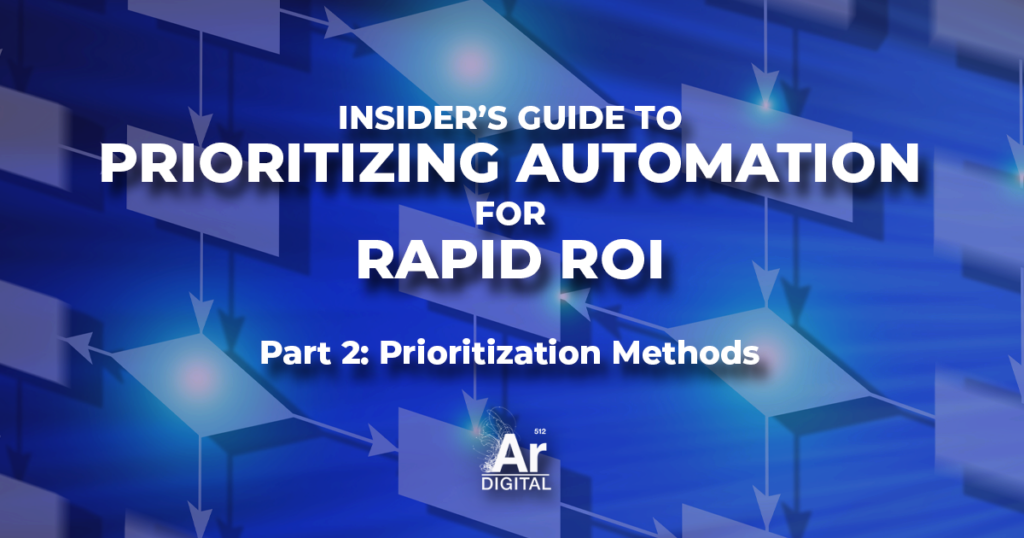How Visual Models Integrate with Prioritization Methods
The journey of automating business processes can feel overwhelming, but it doesn’t have to. By utilizing visual models for clarity – as discussed in Part 1 of this series, Insider’s Guide to Prioritizing Automation for Rapid ROI – Part 1: Visual Models – and strategically prioritizing processes, organizations can navigate this journey with great success. The key is not just to automate but to prioritize automations in such a way that they align with the business objectives and deliver tangible benefits. The truth is, not every process should be automated. By determining and applying the best method for prioritizing your automation project, you and your team can effectively translate your automation efforts into tangible, successful outcomes.
There are many methods for prioritizing automation. Let’s look at the different methods and how the insight gained from the creation of your visual models can inform your decision towards the right method for you and your organization.
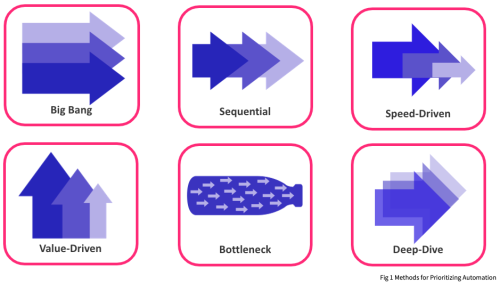
Methods for Prioritizing Automation
1. Big Bang
This approach involves deploying all planned automations simultaneously. It’s akin to a major overhaul of existing processes in one sweeping move. The Big Bang method is most effective in smaller organizations, limited-use systems, or for simpler processes where the risk of disruption is manageable. It’s also suitable when the processes are interdependent, and partial automation might not yield significant benefits. In most cases, Big Bang approaches are NOT recommended as they create unnecessarily time-to-value realizations and introduce more risk than reward. However, as an extreme example, if only one user is working on a few-step process in a system, it might make sense to build and deploy it all at once.
- Integration with Models:
The entire solution, including detailed process models and business rules will need to be modeled in full to support this approach. To deploy everything at once, the team needs to have close to perfect knowledge (100% of requirements are on paper) of what has to be in place.
- Applying Data:
A holistic view from the Process Flow Model ensures that interconnected processes are identified. If data indicates high interdependencies (e.g., 80% of processes are interconnected), a simultaneous overhaul could be more effective.
2. Sequential
This method prioritizes automation in the order that processes occur in the workflow. It follows the natural flow of business operations, automating one process at a time. Sequential automation is ideal when the lifecycle of the entire workflow is spread out over a long duration, like many months. This allows the first high-level step in the process to be automated, and while the business starts using it, the next step can be automated, and so on. By automating earlier steps in the process, value can be realized almost immediately without impacting downstream manual processes. This prioritization technique is analogous to building a plane while flying it, so it doesn’t always logistically work! If it does, more positively, it can be thought of as a “just-in-time” approach to automation.
- Integration with Models:
The Process Flow Model is particularly useful here, including a top-level (L0) process flow to see major chunks of work as well as lower-level flows (L1-L3) capturing the detailed processes when it’s time to do their automation.
- Applying Data:
Statistics from KPIMs, like the duration of each process step at the highest level (L0 processes), can help assess if automating the processes sequentially is feasible.
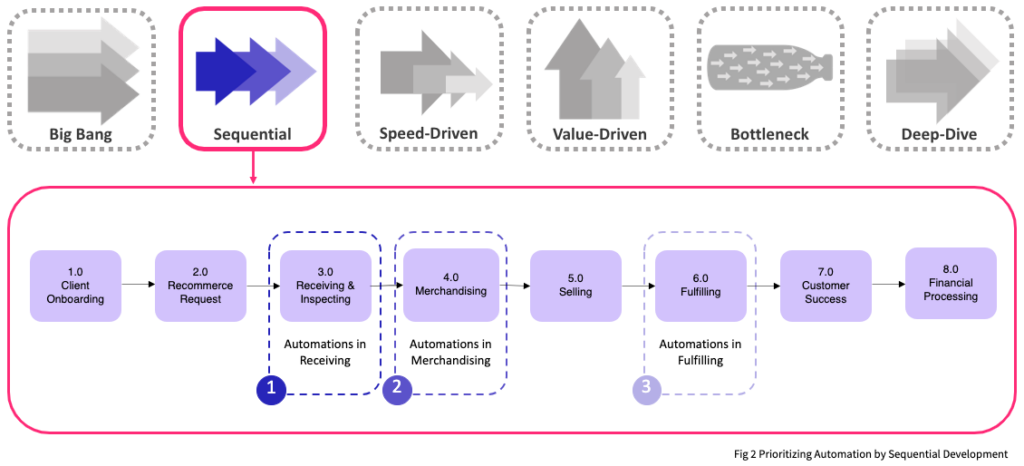
3. Speed-Driven
This approach focuses on prioritizing processes that can be automated quickly, generating immediate results and quick wins. Speed-Driven prioritization is best when quick results are needed to gain stakeholder buy-in or demonstrate the value of automation. It suits scenarios where some processes can be automated with minimal complexity and resource investment.
- Integration with Models:
The process flows will be key to identifying which processes have the least complexity in terms of numbers of steps, deviations in the path, and supporting business rules. The deployment team can use these to assess which process to prioritize first for automation.
- Applying Data:
Measure how quickly you can move from a defined process on paper to a deployed automation. That speed-to-deployment metric will generate excitement among stakeholders.
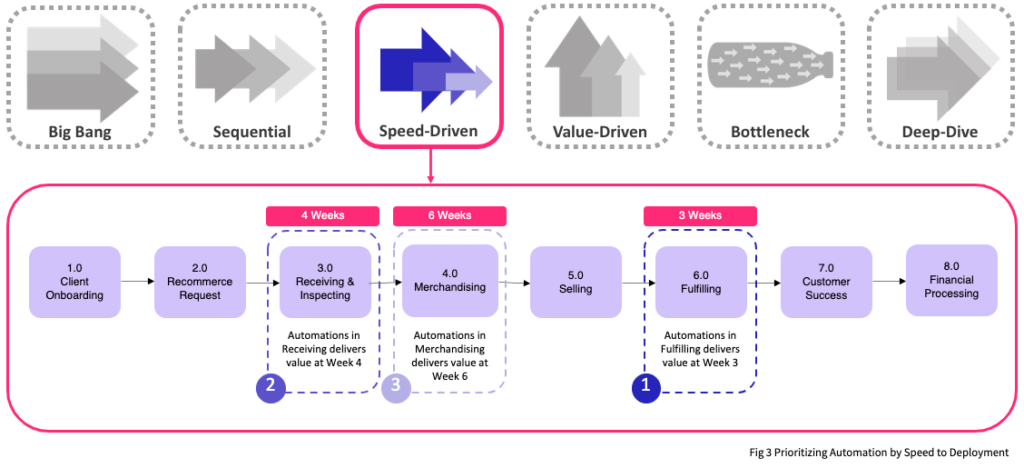
4. Value-Driven
Focusing on processes that offer the highest financial benefits, this method looks at the return on investment as the primary criterion for prioritization. Value-Driven automation is ideal for organizations where future priorities are unclear or there is uncertainty in the business environment. By extracting the most value possible up front, if you need to make course corrections later or even abandon some of the other planned efforts, you still get a good return on the pieces that you worked on up front. Because every project is at risk of being canceled midstream, this is a great method to ensure value is being delivered as soon as possible.
- Integration with Models:
The Business Objectives Model and KPIMs align here to help quantify which processes or parts of processes are aligned with delivering the highest value.
- Applying Data:
Use measurable objectives data from BOMs to prioritize processes. For instance, if automation in a particular process is projected to increase revenue by 20% or cut costs by 15%, it should be prioritized.
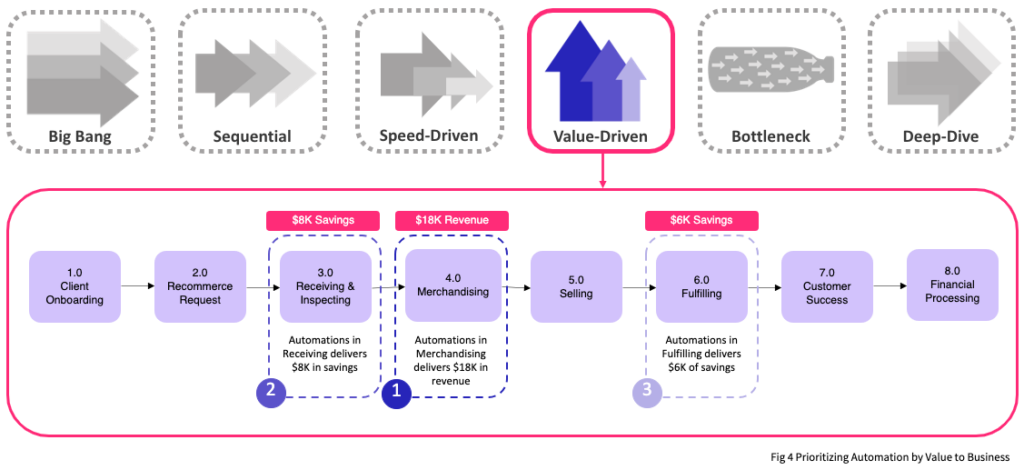
5. Bottleneck
This method targets processes that are major roadblocks in the workflow. By automating these bottlenecks, the overall efficiency of the workflow can be significantly improved. Bottleneck prioritization is particularly effective in scenarios where specific processes are clearly impeding workflow efficiency. It’s an ideal approach to prioritization when throwing people at the problem no longer works, when you want to free up people for more productive work, or when you want to get more productive output from your high-paid and skilled workers.
- Integration with Models:
Process Flows and KPIMs are vital. They help identify where bottlenecks are occurring and their impact on overall operations. In theory, the KPIMs will help identify the biggest pain points in the processes, which indicate which to automate first.
- Applying Data:
Look for data points like process delay times. Also, consider how many people are manually doing process steps currently. If a bottleneck process is causing a 30% delay in overall operations, targeting it becomes a priority.
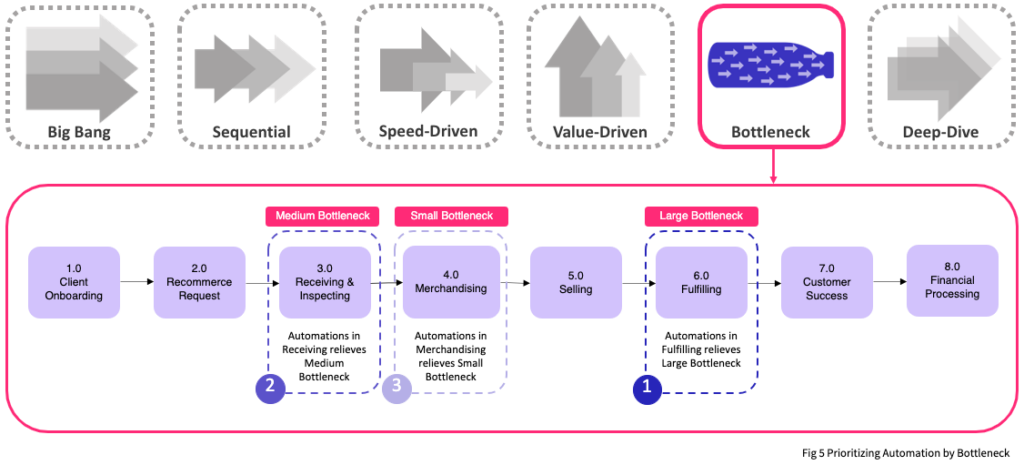
6. Deep-Dive (Iterative)
This iterative method involves implementing multiple versions of a process – refining and enhancing it with each iteration. This approach is about continuous improvement and evolution. The Deep-Dive method is suitable for complex processes that require fine-tuning and gradual enhancement. It’s ideal in environments that support agile methodologies and continuous feedback loops, and where imperfection in the first rounds of automation are acceptable.
- Integration with Models:
This method aligns well with the iterative nature of KPIMs, where continuous improvement is key. Careful analysis of process flows will help create slices of steps and business rules to automate in iterations.
- Applying Data:
Use data trends from KPIMs over time to identify processes that, while not initially the most inefficient, have room for iterative enhancements for long-term gains. It will be important to measure at each iteration to demonstrate continuous improvement.
Keep in mind, some of these methods can be combined (e.g., Value-Driven + Deep-Dive) and one method might not work for all projects or automations within one organization. There is no single answer to “Which prioritization approach is best?”, because they each have their advantages. It is important to understand factors like your organization’s goals, environment, culture, future outlook, and sense of urgency. Those factors will help select one or more of these approaches to prioritize automation work.
Ultimately, the application of these prioritization methods, informed by data and statistics from visual models, enables a data-driven approach to automation. This approach ensures that automation efforts are aligned with strategic objectives, operational realities, and measurable performance indicators, maximizing the impact and efficiency of automation projects.
Visit Insider’s Guide to Prioritizing Automation for Rapid ROI – Part 1 to learn more about using visual models to prioritize automation.

